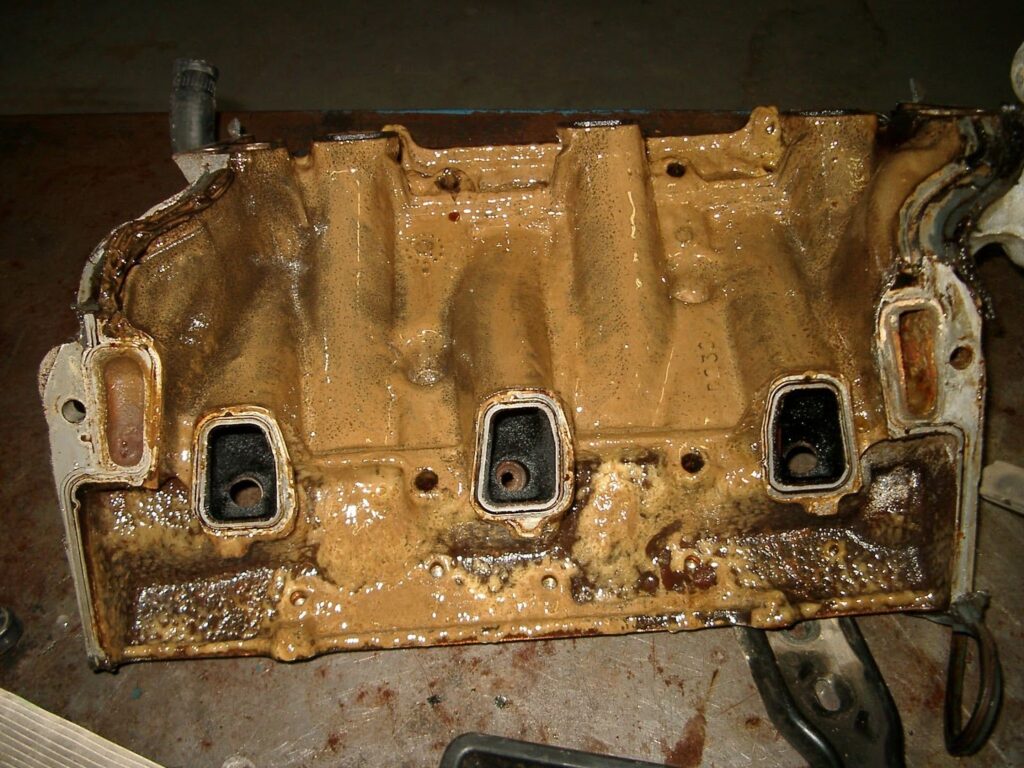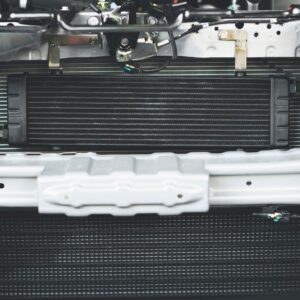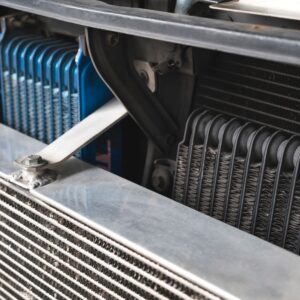Have you noticed the presence of coolant in your engine oil? This is a serious issue that can seriously damage your engine. Engine oil and coolant circulate through distinct channels in your engine. Oil and coolant should never mix. These two liquids can only mix when something goes wrong in your engine or oil cooler.
Engine oil is crucial for maintaining engine function because oil lubricates components and prevents excessive wear. The presence of coolant is going to compromise the motor oil’s lubricating properties, potentially causing extensive engine damage.
What Are the Symptoms of Coolant Mixing With Engine Oil?

You might have discovered coolant mixed with your engine oil because the oil on the dipstick has changed color. The coolant in oil makes it color brown, similar to chocolate milk. Motor oil should have a golden or amber hue.

Another sign of coolant mixing with your oil is low coolant levels. If your coolant reservoir is empty and there are no signs of leaks, you should check your engine oil.
How long can you drive with coolant in the engine oil? It’s hard to say how long an engine can run with this issue. Some vehicles drive a long way with coolant in the oil, but it needs to be handled quickly.

Your engine is likely going to wear out excessively as soon as coolant is introduced. However, it’s unclear how long it will take until the engine gets damaged to the point that it overheats or shuts down.
What You Should Do After Discovering Coolant in Oil?
If you’ve noticed the previously mentioned symptoms, then you shouldn’t drive your vehicle further. Otherwise, you risk wearing out or overheating your engine, which can cause major engine damage and expensive repairs. You should immediately head to a mechanic to have your vehicle diagnosed and repaired. Finding the source of the leak is the most important part of the job.
The repair will involve draining all the coolant and engine oil from your vehicle to remove all the contaminated fluids. Afterward, the oil and coolant channels must be flushed to remove the remaining contaminants.
A blown head gasket, a cracked cylinder head or engine block, or faulty engine gaskets or seals are the most common causes for coolant to mix with engine oil. These issues will need to be resolved before your engine can be filled up with fluids and started. Otherwise, the fluids will continue mixing.
The repair process of fixing these components is going to vary for each vehicle model. Follow the steps in your vehicle’s repair manual or have the task done by a professional.
How Does Coolant in Oil Affect Your Engine?
When coolant and engine oil mix, several things are going to happen:
Reduced Lubrication
Coolant mixing with the oil will make your vehicle’s oil turn into a gel, which will reduce oil flow inside your engine. Coolant will also affect the oil’s ability to lubricate engine components.
Increased Abrasion and Engine Wear
Contaminated oil is going to absorb more soot from combustion. Oil is formulated to absorb the soot that the engine generates using various additives. The additives also disperse the soot, which means the soot doesn’t clump together and create abrasive particles. However, coolant will affect the oil’s ability to disperse the soot, increasing abrasion and component wear.
Aside from soot, abrasive oil balls will also form when coolant mixes with oil. These tiny oil balls are 5 to 40 microns in size and they can erode engine surfaces such as cylinder walls.
Engine Corrosion
Glycol in coolant also breaks down in the high temperatures present in the oil passages, forming glycolic acid. This substance corrodes certain metals in your vehicle’s engine, forming metal salts.
Coolant in engine oil is an indicator of a serious engine problem. If you notice signs of coolant in your oil, you should stop using your vehicle and seek professional help immediately. You can prevent further damage and ensure your engine’s reliability as long as you promptly respond to symptoms and address the root cause immediately.
How to Prevent Coolant From Leaking into Engine Oil
The best ways to prevent coolant from leaking into the engine oil include regular maintenance, addressing problems as soon as they manifest, and applying sealant to the radiator to prevent leaks.
Regular Maintenance
One of the most reliable ways to prevent almost any automotive problem is getting regular maintenance. It’s strongly recommended to bring your vehicle to a mechanic at least twice a year for inspection. This way, mechanics can closely examine your vehicle, letting them single out inoperative parts and recommend fixes or replacements.
Address Symptoms ASAP
If you notice symptoms such as milky, discolored motor oil or a sweet scent coming from the exhaust, then it’s very likely there’s already a coolant leak. If this happens, consult a mechanic immediately and get their recommendations on what parts to replace.
Apply Sealant to the Radiator
Sealant can prevent radiator leaks, reducing the risk of coolant leaking into the engine oil. Though this won’t fix the problem permanently, it can work as a temporary fix before bringing your vehicle to a mechanic.
Where to Find OE-Grade Engine Parts for Your Ride
Coolant in your engine oil is never a good sign. Unfortunately, this symptom usually means that something in your engine has been broken beyond repair, and the only way to get your vehicle back on track is by replacing the damaged component.
Here at CarParts.com, dealing with damaged engine parts doesn’t have to be a hassle. Our website has everything you need to get your vehicle back in tip-top shape, including head gaskets, cylinder heads, and more. All you have to do is enter your daily driver’s year, make, and model into our vehicle selector, and leave the rest to us.
Take your pick from a variety of engine parts that passed stringent testing procedures from the most reputable names in the industry. Shopping from us means you get high-quality parts that are precision-engineered to meet your vehicle’s needs.
Enjoy the best deals here at CarParts.com. All our products come with a low-price and lifetime replacement guarantee, helping you get the best value for your money. Order now, and we’ll deliver the parts you need straight to your doorstep in as fast as two business days.
Don’t miss out on the best deals on the market, and shop for OE-grade engine parts right here at CarParts.com!
Any information provided on this Website is for informational purposes only and is not intended to replace consultation with a professional mechanic. The accuracy and timeliness of the information may change from the time of publication.
































